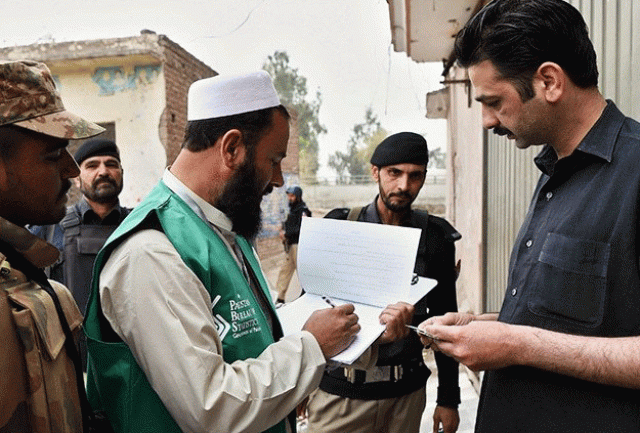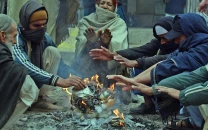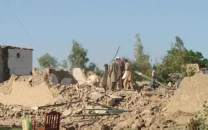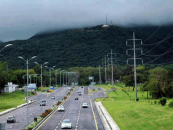Census validation: ‘Disputed names’ in PBS-named panel
Sindh views PBS as going back on deal reached with political parties

PHOTO: AFP
In a meeting of the Council of Common Interest (CII) presided by the PM, all the parties had agreed to conduct the PES under supervision of a three-member Census Commission after which the Pakistan People’s Party (PPP) voted in favour of the 24th Amendment in the Constitution.
However, Senator Taj Haider, who is a member of a four-member Senate committee to monitor and oversee the PES, has protested against ‘malicious intents’ of the federal government.
6th census findings: 207 million and counting
He said the PBS in a blatant violation of the agreement signed by all political parties has arbitrarily notified a ‘fake’ census commission containing 9 members for the PES and has asked the PM to review the methodology of the validation exercise.
Haider, who has been single-handedly contesting the case of Sindh in the upper house, asked how PM can review the methodology when all political parties including the Leader of the House Raja Zafarul Haq agreed upon the methodology of validation exercise.
“The PPP only signed the delimitation bill when the PML-N led federal government and the PM assured to conduct the PES on a defacto basis –ie, on condition that every member of a household present in a house on that day shall be counted,” he said.
A Monitoring and Oversight Committee, comprising four senators – Taj Haider, Hasil Bazinjo, Mushahidullah Khan and Mushahid Hussain Syed – had to constitute the Census Commission of three noted demographers through mutual consultation. Later, they agreed to have five demographers, one each from every province and one from Islamabad.
However, the PBS has notified a 9-member Census Commission which includes all the disputed names due to which the provisional report of census 2017 became disputed.
Terming it a very serious matter, Haider said firstly the census was conducted on dejure basis in which migrants and illegal residents were excluded of the provinces population and hence the population of Sindh was largely affected.
“Had the census been carried out on defacto basis then there would have chances of 8% increase of Sindh’s population in provisional result of census 2017.” According to him, the defacto methodology is used in 180 countries and in more than 50 countries curfew is imposed so that every individual living in a certain area can be counted.
Census results: Just over 10,000, transgender people only 0.005% of Pakistan's population
He said 8% increase in population means 84 National Assembly seats from Sindh which right now has 61 seats in the lower house. Hence the PMLN-led federal government and the PBS are worried, he added.
“Sindh would be getting Rs24billion less from the divisible pool of federal government since its 83% weightage is on population after reducing the population of Sindh by at least 8%. This would further bring loss to Sindh province in long term if it is not rectified,” he said.
He further pinpointed that household size in a multiple indicator cluster survey done in 2014 has been reduced to up to 2 persons in 11 districts of northern Sindh. “How can a family size go down to 2 persons in three years as shown in provisional report of 2017 national survey?” he inquired.
According to a renowned demographer and who is a member of census commission through a mutual consultation Dr Mehtab S Karim, Sindh has suffered the most in census. However, the validation survey if carried out as agreed upon by all parties would certainly help address the reservations of Sindh.
Dr Karim also asked how the share of Sindh’s population can remain23% of the country’s total population since 1981, whereas Sindh has experienced the most inward population migration.
“It’s a puzzle how the growth rate of Sindh has remained the same as that of average national growth rate. However, Sindh has experienced the heavy influx of migration.”
Delimitation of constituencies according to 2017 census under way
It was decided in the CII in December that a validation survey will be conducted in 5% of the blocks in order to determine whether the census was conducted properly. “My research analysis says Sindh’s population is at least 27% of country’s total population contrary to 23% recorded in provisional report of census,” he claimed.
Sindh, Balochistan and Khyber-Pakhtunkwa (K-P) have a growth rate of 4% whereas Punjab’s growth rate is 3.5%. “Migration is taking place from Punjab and the K-P to Sindh and overseas,” he added.
Karim said the exercise is supposed to take three months but no meeting has yet taken place among the members of Census Commission to decide the TORs.
He said the final report of the population census 2017 by each district is expected in April and if it comes before the PES then the disputed results of provisional report will be made final, hence increasing reservations of smaller provinces.
"Sindh would be the province suffering the most in the NFC [National Finance Commission] awards and allocation of the National Assembly seats for next 10 years," he added.



















COMMENTS
Comments are moderated and generally will be posted if they are on-topic and not abusive.
For more information, please see our Comments FAQ